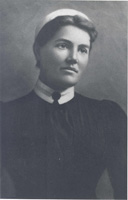“Now more than ever, there’s a strong call to #PressForProgress, motivating and uniting friends, colleagues and whole communities to think, act and be gender inclusive.”
So what does progress look like in nursing—a traditionally women-dominated field? Even in 2018, only 11 percent of all registered nurses are male, although we are up to about 15 percent at the Johns Hopkins School of Nursing. What’s more, RNs make up the biggest chunk of the global health workforce, 23 percent. Worldwide, that’s a lot of women in health sciences.
For nursing as a discipline, you could call “progress” the historical timeline of nursing education, in other words its progress from a trade into a profession—and then into a diverse profession. Formal nursing education began with hospital school training under the Florence Nightingale model in the 19th century. Even then, research showed that a more educated nurse yielded better results for patients and communities.
Several nurses affiliated with the Johns Hopkins School of Nursing helped shape the field early on:
Isabel Hampton Robb was the first principal of the Johns Hopkins Hospital Training School—the precursor to the Johns Hopkins School of Nursing. The school itself was the first U.S. nursing school developed under the Florence Nightingale model. Later, Robb became the first president of the American Nurses Association. We celebrate her legacy with nursing ethics.
Mary Adelaide Nutting graduated in the first class of the Johns Hopkins Hospital Training School. Eventually she became the school’s principal and left her mark by extending the training program from two to three years, persuading the school to offer scholarships, and restructuring the curriculum to include field experience.
Later on, Nutting helped found the American Journal of Nursing, helped establish the Columbia University School of Nursing, became the first professor of nursing, and helped shape the role of nurses in the U.S. Army during World War I.
Lavinia Dock was an assistant superintendent at the Johns Hopkins Hospital Training School under Isabel Hampton Robb. She wrote the first manual of drugs for nurses as well as several textbooks. Along with Robb and Mary Adelaide Nutting, she helped found the precursor to the National League for Nursing.
Lavinia Dock was also active in the National Women’s Party. She campaigned for the 19th Amendment that allowed women to vote as well as for legislation about nursing education.
Superintendent Anna D. Wolf took over in 1940. She fought to raise education and patient-care standards, laying the groundwork for the Johns Hopkins Hospital Training School for Nurses to become the Johns Hopkins University School of Nursing. It opened in 1984, a year before her death. Wolf fought an uphill battle—Johns Hopkins University was all-male at the time and contemporaries thought admitting female nursing students would lower the school’s standards.
Today researchers frequently note that science, technology, engineering, and math (STEM) fields have been predominantly male occupations, with historically low participation among women. However nearly 90 percent of American nurses are women and more than half of American RNs have a bachelor’s degree or above. Furthermore, the American Association of Medical Colleges reported that, in 2017, for the first time more women were enrolled in medical school than men.
As STEM careers continue to grow, nursing is in high demand. We’re facing a global shortage of 17.4 million qualified health care workers, including over 9 million nurses, according to the World Health Organization. We need nurses and nurse educators to maintain a functioning health care system.
You can also see “progress” in the increasing diversity of the field. This is important because a diverse nursing workforce contributes to a deeper understanding of the socioeconomic factors that impact health, and ultimately better care.
The first African-American woman to be a tenured full professor at Johns Hopkins University, Fannie Gaston-Johansson is an internationally renowned nurse educator, researcher, and clinical practitioner. She is a “Living Legend” of the American Academy of Nursing. It is the organization’s highest honor, recognizing far-reaching and sustained impact on nursing and health care.
Today in the U.S., 9.9 percent of RNs are black or African American (non-Hispanic); 8.3 percent are Asian; 4.8 percent are Hispanic or Latino; 1.3 percent categorize themselves as two or more races; 0.4 percent are American Indian or Alaskan Native. It’s worth noting, however, that black or African American nurses have more master’s or doctoral degrees than any other race, 14.6 percent, and Asian nurses are most likely to enter nursing with a bachelor’s degree.
So where do we go from here? The 2018 theme for International Women’s Day is #PressForProgress. At the Johns Hopkins School of Nursing, we’re pressing for progress by celebrating the achievements in our past and nurturing our students, who will impact the field of nursing to come. We also work to forge positive visibility of nurses. To learn more, check out our #WeGotThis campaign.

ABOUT THE AUTHOR: SYDNEE LOGAN
Sydnee Logan is the Social Media and Digital Content Coordinator for Johns Hopkins School of Nursing. She shares what’s going on here with the world.






